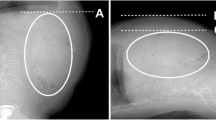Summary
The introduction of new equipment for encephalography and ventriculography which allows the easy and rapid use of tomography has brought about a considerable improvement in the visualization of the anatomical structures of the posterior fossa and especially of the fourth ventricle. In order to have a satisfactory idea of the anatomical details of the fourth ventricle at pneumography two main prerequisites have to be fulfilled: the fourth ventricle must be completely filled with air and the beam direction must be chosen to depict the relevant structures, the latter being especially critical in the PA projections. The position of the head that is most effective for the exchange of ventricular CSF with air obviously cannot be the most suitable position for keeping the air within the fourth ventricle and aqueduct. To obtain complete filling of the fourth ventricle special measures have to be taken during pneumoencephalography and ventriculography. The second prerequisite, a suitable beam direction, is of importance not only in taking plain films but also for tomography. In this context the advantages and disadvantages of different patterns of tomographic movements and angles are discussed.
Résumé
L'introduction de nouveaux équipements pour l'encéphalographie et la ventriculographie permettant l'utilisation facile et rapide de la tomographie a apporté une amélioration considérable dans la visualisation des structures anatomiques de la fosse postérieure et plus spécialement du IVe ventricule. — Afin d'obtenir une vue satisfaisante des détails anatomiques du IVe ventricule en pneumographie, duex conditions principales doivent être remplies: — le IVe ventricule doit être complètement insufflé et le faisceau doit être centré sur les structures intéressées, celles-ci étant particulièrement délicates sur les projections postéro-antérieures. La position de la tête la plus adéquate pour l'échange entre le liquide céphalo-rachidien ventriculaire et l'air n'est évidemment pas la meilleure position pour garder l'air dans le IVe ventricule et l'aqueduc. Afin d'obtenir une insufflation complète du IVe ventricule il est nécessaire de recourir à des mesures spéciales au cours de la pneumoencéphalographie. — La deuxième condition, c'est-à-dire une direction adéquate du faisceau, est importante non seulement lors de la prise de clichés conventionnels mais aussi pour la tomographie. Dans ce travail l'auteur discute les avantages et les inconvénients de différents types de mouvements et d'angles tomographiques.
Zusammenfassung
Die vorliegende Arbeit beschäftigt sich ausführlich mit der Darstellung des IV. Ventrikels (sowohl mittels Übersichtsaufnahmen als auch mittels Tomographie) in 2 Ebenen. Dabei kommt es besonders auf die Haltung des Kopfes bei der Luftfüllung an, da nur bei einer kompletten Luftfüllung des IV. Ventrikels und bei einer korrekten Einstellung des Zentralstrahls eine genügende Darstellung des IV. Ventrikels in allen Abschnitten erreicht werden kann.
Similar content being viewed by others
References
Corrales, M.: A radiologic investigation of the fourth ventricle. Elema-Schönander AB, Solna, Stockholm: 1972
Corrales, M.: Fourth ventricle. III. Intra- and extraaxial tumours. Acta radiol. Diagnosis 13, 370–390 (1972)
Corrales, M., Greitz, T.: Fourth ventricle. I. A morphologic and radiologic investigation of the normal anatomy. Acta radiol. Diagnosis 12, 113–133 (1972)
Corrales, M., Greitz, T.: Fourth ventricle. II. Tumours of the cerebellum. Acta radiol. Diagnosis 12, 241–270 (1972)
Falk, B.: Encephalography in cases of intracranial tumour. Acta radiol. 40, 220–233 (1953)
Greitz, T., Grepe, A.: Mimer II and rotating chair. Application in neuroradiology. Stockholm: Elema-Schönander 1967
Liliequist, B.: (a) The subarachnoid cisterns. An anatomic and roentgenologic study. Acta radiol. Suppl. No. 185 (1959)
Liliequist, B.: (b) Pontine angle tumour. Acta radiol. Suppl. No. 186 (1959)
Liliequist, B.: Lumbar encephalography in pontine and intracerebellar tumours. Acta radiol. Diagnosis 1, 593–601 (1963)
Lindgren, E.: Some aspects on the technique of encephalography. Acta radiol. 31, 161–177 (1949)
Lindgren, E.: Encephalographic examination of tumours in the posterior fossa. Acta radiol 34, 331–338 (1950)
Robertson, E. G.: Encephalography. Melbourne: Macmillan 1941
Ruggiero, G.: L'encéphalographie fractionnée. Paris: Masson 1957
Author information
Authors and Affiliations
Rights and permissions
About this article
Cite this article
Greitz, T. Technical aspects of the pneumoencephalographic and ventriculographic examination of the fourth ventricle. Neuroradiology 6, 259–269 (1974). https://doi.org/10.1007/BF00345786
Issue Date:
DOI: https://doi.org/10.1007/BF00345786




